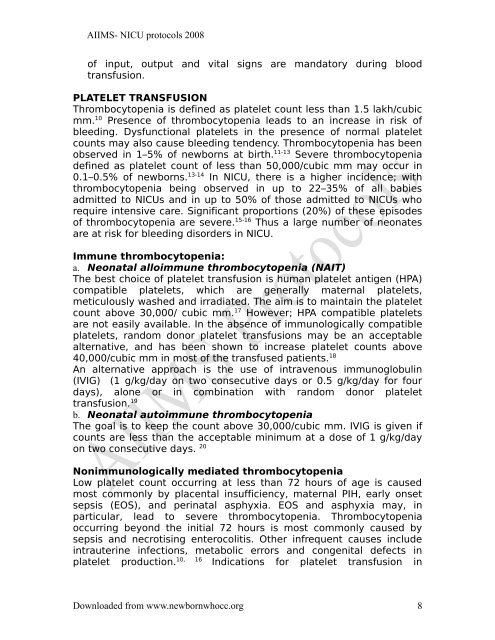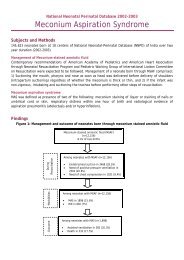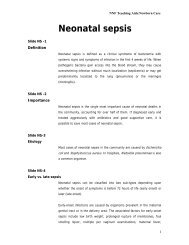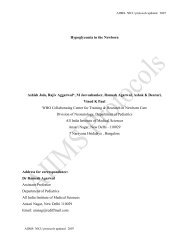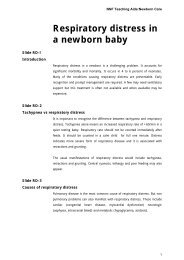Blood and blood component therapy in neonatology - New Born Baby
Blood and blood component therapy in neonatology - New Born Baby
Blood and blood component therapy in neonatology - New Born Baby
You also want an ePaper? Increase the reach of your titles
YUMPU automatically turns print PDFs into web optimized ePapers that Google loves.
AIIMS- NICU protocols 2008<br />
of <strong>in</strong>put, output <strong>and</strong> vital signs are m<strong>and</strong>atory dur<strong>in</strong>g <strong>blood</strong><br />
transfusion.<br />
PLATELET TRANSFUSION<br />
Thrombocytopenia is def<strong>in</strong>ed as platelet count less than 1.5 lakh/cubic<br />
mm. 10 Presence of thrombocytopenia leads to an <strong>in</strong>crease <strong>in</strong> risk of<br />
bleed<strong>in</strong>g. Dysfunctional platelets <strong>in</strong> the presence of normal platelet<br />
counts may also cause bleed<strong>in</strong>g tendency. Thrombocytopenia has been<br />
observed <strong>in</strong> 1–5% of newborns at birth. 11-13 Severe thrombocytopenia<br />
def<strong>in</strong>ed as platelet count of less than 50,000/cubic mm may occur <strong>in</strong><br />
0.1–0.5% of newborns. 13-14 In NICU, there is a higher <strong>in</strong>cidence; with<br />
thrombocytopenia be<strong>in</strong>g observed <strong>in</strong> up to 22–35% of all babies<br />
admitted to NICUs <strong>and</strong> <strong>in</strong> up to 50% of those admitted to NICUs who<br />
require <strong>in</strong>tensive care. Significant proportions (20%) of these episodes<br />
of thrombocytopenia are severe. 15-16 Thus a large number of neonates<br />
are at risk for bleed<strong>in</strong>g disorders <strong>in</strong> NICU.<br />
Immune thrombocytopenia:<br />
a. Neonatal alloimmune thrombocytopenia (NAIT)<br />
The best choice of platelet transfusion is human platelet antigen (HPA)<br />
compatible platelets, which are generally maternal platelets,<br />
meticulously washed <strong>and</strong> irradiated. The aim is to ma<strong>in</strong>ta<strong>in</strong> the platelet<br />
count above 30,000/ cubic mm. 17 However; HPA compatible platelets<br />
are not easily available. In the absence of immunologically compatible<br />
platelets, r<strong>and</strong>om donor platelet transfusions may be an acceptable<br />
alternative, <strong>and</strong> has been shown to <strong>in</strong>crease platelet counts above<br />
40,000/cubic mm <strong>in</strong> most of the transfused patients. 18<br />
An alternative approach is the use of <strong>in</strong>travenous immunoglobul<strong>in</strong><br />
(IVIG) (1 g/kg/day on two consecutive days or 0.5 g/kg/day for four<br />
days), alone or <strong>in</strong> comb<strong>in</strong>ation with r<strong>and</strong>om donor platelet<br />
transfusion. 19<br />
b. Neonatal autoimmune thrombocytopenia<br />
The goal is to keep the count above 30,000/cubic mm. IVIG is given if<br />
counts are less than the acceptable m<strong>in</strong>imum at a dose of 1 g/kg/day<br />
on two consecutive days. 20<br />
Nonimmunologically mediated thrombocytopenia<br />
Low platelet count occurr<strong>in</strong>g at less than 72 hours of age is caused<br />
most commonly by placental <strong>in</strong>sufficiency, maternal PIH, early onset<br />
sepsis (EOS), <strong>and</strong> per<strong>in</strong>atal asphyxia. EOS <strong>and</strong> asphyxia may, <strong>in</strong><br />
particular, lead to severe thrombocytopenia. Thrombocytopenia<br />
occurr<strong>in</strong>g beyond the <strong>in</strong>itial 72 hours is most commonly caused by<br />
sepsis <strong>and</strong> necrotis<strong>in</strong>g enterocolitis. Other <strong>in</strong>frequent causes <strong>in</strong>clude<br />
<strong>in</strong>trauter<strong>in</strong>e <strong>in</strong>fections, metabolic errors <strong>and</strong> congenital defects <strong>in</strong><br />
platelet production. 10, 16 Indications for platelet transfusion <strong>in</strong><br />
Downloaded from www.newbornwhocc.org 8


